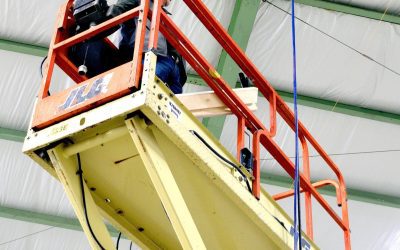Aerial Lift Operator Heat Safety: OSHA Rules, Symptoms & Prevention Tips
Heat Safety for Aerial Lift Operators: How to Prevent Heat-Related Illness on the Job
Why Heat Stress Is a Serious Risk for Aerial Lift Workers
Aerial lift operators often work outdoors, high above the ground, and directly under the sun. Whether you’re on a construction site, maintaining electrical lines, or handling building repairs, the heat is intense—and there’s usually no shade.
Heat stress can lead to serious problems like dehydration, dizziness, or even heat stroke. Because of the gear aerial lift workers wear—like harnesses, helmets, and layered PPE—their bodies heat up even faster.
This guide walks through what aerial lift workers and their supervisors need to know about OSHA’s heat stress rules and how to stay safe on hot job sites.
What Does OSHA Require for Heat Safety on Elevated Worksites?
OSHA requires employers to keep all workers safe from known risks—including high heat. For aerial lift operators, that means added attention due to long exposure to sun, PPE that traps heat, and physical strain.
To stay compliant, employers should:
- Provide cool drinking water at or near the lift base
- Offer regular shaded or air-conditioned rest breaks
- Adjust work schedules to avoid peak heat hours
- Train workers on early warning signs of heat illness
- Make sure PPE is breathable and properly fitted
These basic steps reduce the risk of heat-related illness at height.
How Does OSHA Enforce Heat Safety for Lift Operators?
OSHA can inspect a job site after an accident, complaint, or as part of a routine safety check. For aerial lift operations, they’ll look for:
- Heat safety training records
- Evidence of scheduled water and rest breaks
- Access to shade or cooling stations
- Use of gear like cooling vests or hydration packs
Employers must prove they are actively managing heat stress. Fines and legal action can result if a worker becomes ill and the company wasn’t prepared.
What Training Does OSHA Require for Aerial Lift Heat Safety?
Operators working outdoors in hot weather must know how to protect themselves and their coworkers from heat-related illness.
Training should include:
- How heat affects the body at height
- Symptoms of heat exhaustion and heat stroke
- When and how to hydrate and rest
- How to use cooling gear with fall protection systems
- Emergency steps if a worker shows symptoms on the lift
Supervisors should get extra training on how to monitor workers from the ground and make fast decisions when someone needs help.
How to Spot Heat Stress Symptoms in Aerial Lift Operators
At height, heat stress symptoms can develop quickly—and going unnoticed for even a few minutes can be dangerous.
Watch for signs like:
- Heavy sweating
- Weakness or dizziness
- Headache or nausea
- Hot, red skin or clammy, pale skin
- Rapid heart rate
Operators in harnesses may not feel symptoms as clearly, so it’s important for coworkers and ground spotters to watch closely and respond quickly.
How to Prevent Heat Stress in Aerial Lift Environments
Heat safety starts before the shift begins. Planning ahead can make the difference between a safe day and a medical emergency.
Smart prevention strategies:
- Shift start times earlier to avoid afternoon heat
- Encourage pre-shift hydration—not just during breaks
- Provide shaded rest areas on-site and near lifts
- Install portable misting fans or tents for cooling
- Use high-visibility, moisture-wicking uniforms under harnesses
Rotating tasks and limiting time at elevation during peak sun hours is another effective way to prevent overheating.
Tools and Equipment That Help Aerial Lift Crews Beat the Heat
Technology plays a big role in modern heat safety planning.
Recommended tools include:
- Cooling vests designed to be worn under fall protection harnesses
- Wearable sensors that monitor heart rate, body temperature, and stress
- Hydration backpacks that clip into belts or harnesses for hands-free use
- Heat index monitoring devices that send alerts when conditions become unsafe
These solutions support real-time decision-making and early intervention—two critical factors when working at height.
What’s New in OSHA’s Heat Stress Guidelines?
OSHA now encourages companies to take proactive steps using modern technology and updated work practices.
New focus areas include:
- Real-time monitoring with wearable tech
- Automated alerts for dangerous heat conditions
- Custom work-rest cycles based on weather and workload
- Recordkeeping systems to track heat-related incidents and improvements
These updates help reduce the risk of heat stroke and improve overall job site safety.
Frequently Asked Questions: Heat Safety for Aerial Lift Workers
Why is heat stress more dangerous for aerial lift operators?
They work in full sunlight, wear heavy gear, and often stay in one position. These factors increase the body’s heat load quickly.
What are signs that an operator might be overheating?
Look for sweating, confusion, pale or flushed skin, and fast breathing. Immediate action is needed.
Can cooling vests be used with safety harnesses?
Yes. Some cooling vests are designed to fit under fall protection gear without affecting movement or safety.
How can rest and hydration work with aerial jobs?
Plan ground-level breaks, use hydration backpacks, and limit time aloft during extreme heat hours.
What role does technology play?
Tools like wearable sensors and portable weather trackers help supervisors make safer decisions based on real-time conditions.
What should supervisors do when someone shows symptoms?
Lower the platform as soon as possible, give the worker water, move them to shade, and monitor closely. Call for help if symptoms don’t improve.
